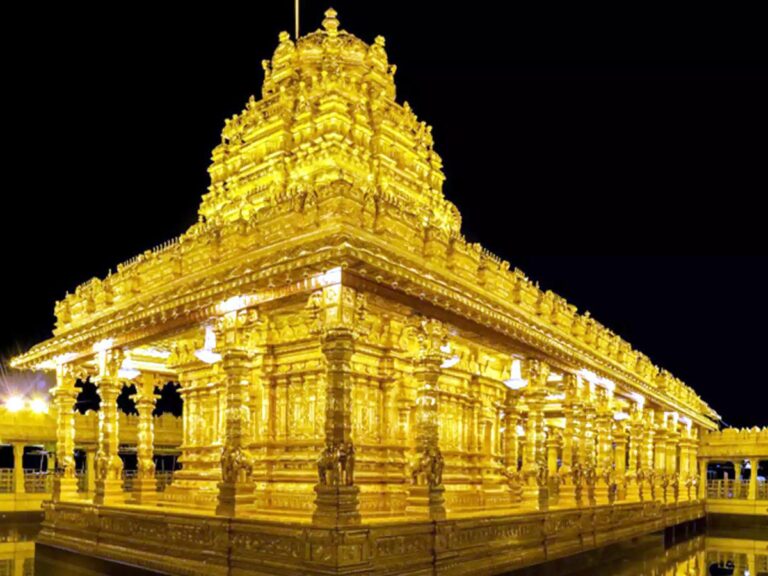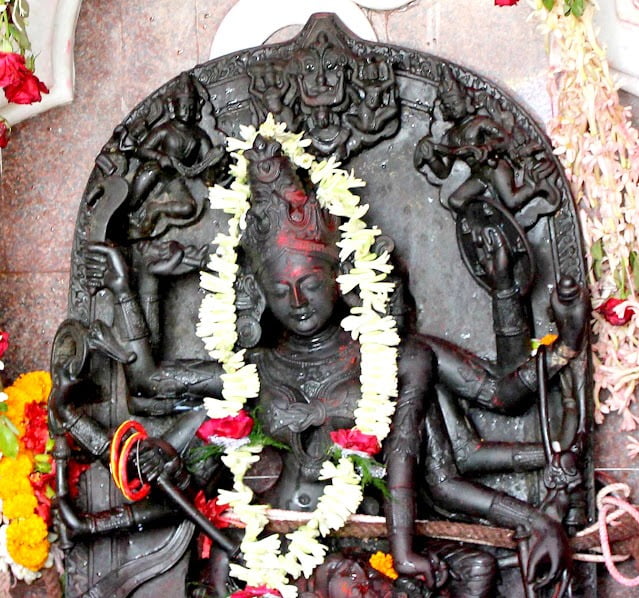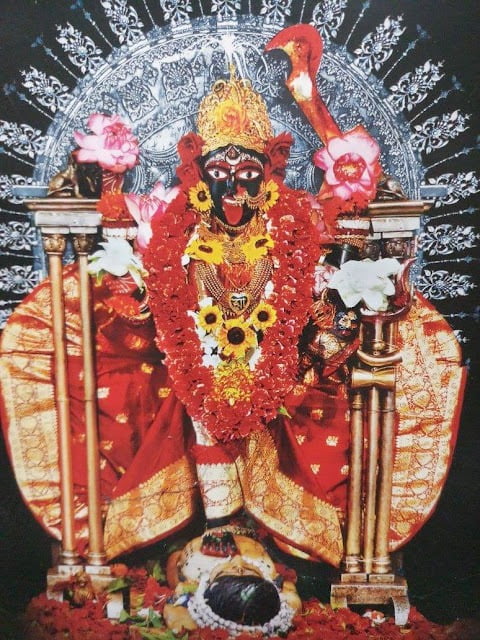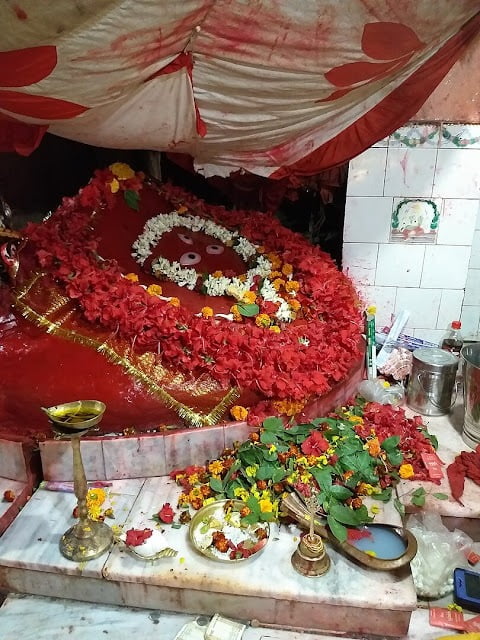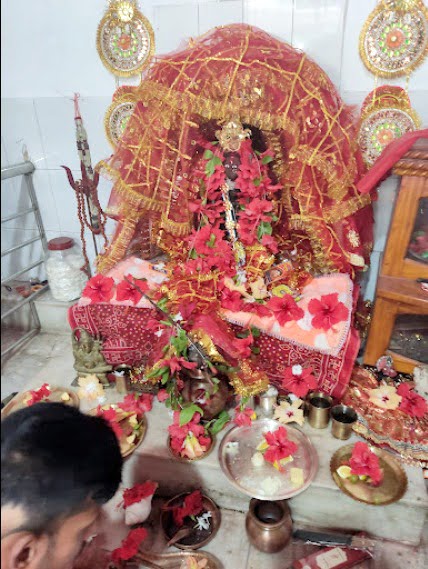Thirumandhamkunnu Temple Angadipuram
As we set off for the Thirumandhamkunnu Temple, I want you to close your eyes for a second and visualize a long, long time ago. A time when gods roamed the earth, and wondrous things occurred every day. The breeze that surrounds us here in Kerala is always so crisp, and as we approach the temple, you can feel something special, as if there is a hum in the air. This temple is not a structure; it’s a living, breathing tale, and I assure you, by the time we’re done visiting, your hearts will be full of awe. So, let’s enter this world of enchantment, yes?

Contents
- 1 A Glimpse into the Past: The History of Thirumandhamkunnu Temple
- 2 Tales from the Heavens: The Legend of Thirumandhamkunnu Temple
- 3 Why This Place is Special: The Significance of Thirumandhamkunnu Temple
- 4 Astonished by the Art: The Architecture of Thirumandhamkunnu Temple
- 5 Whispers of the Divine: Myths and Beliefs at Thirumandhamkunnu Temple
- 6 When to Visit: Thirumandhamkunnu Temple Timings
- 7 Beyond the Temple Walls: Hindu Places to Visit Near Thirumandhamkunnu Temple
- 7.0.1 Shri Jogadya Shaktipeeth, Kshirgram, West Bengal
- 7.0.2 Vibhash Shakti Peeth | Kapalini (Bhimarupa) Shaktipeeth
- 7.0.3 Ujani Shaktipeeth Shri Mangal Chandi Temple
- 7.0.4 Nandikeshwari Temple | Nandipur Shakti Peeth, Sainthia
- 7.0.5 Shree Trishrota Maa Bhramoree Debir Shaktipeeth Temple
- 7.0.6 Anandamayee Shakti Peeth Temple
- 8 Your Journey to the Divine: How to Get to Thirumandhamkunnu Temple
A Glimpse into the Past: The History of Thirumandhamkunnu Temple
Now, let’s discuss the history of this amazing place. The Thirumandhamkunnu Temple isn’t recent; it’s actually, really, really old, like, older than your grandparents’ grandparents’ grandparents! Picture centuries going by, and this temple still standing, witnessing everything happening. Historians and elder wise men think that it was constructed a very long time ago, maybe even in the 9th or 10th century. That’s more than a thousand years ago! Can you picture it?
They say that this temple was in a very significant position among the kings and queens who ruled this region of Kerala, particularly the Valluvanad kings. They looked after it sincerely, constructing new sections and ensuring it remained beautiful. Imagine them as the guardians of this holy site, ensuring that all would be able to visit and offer their prayers to the divine Mother. Years have passed, and numerous individuals have come and prayed here, each contributing their own wishes and stories to its rich fabric. The stones of Thirumandhamkunnu Temple have witnessed so much, heard innumerable prayers, and seen thousands of smiles and requests. It’s like a huge old book, in which every stone is a page containing history.
Read More>> Panch Kedar Temples in Uttarakhand
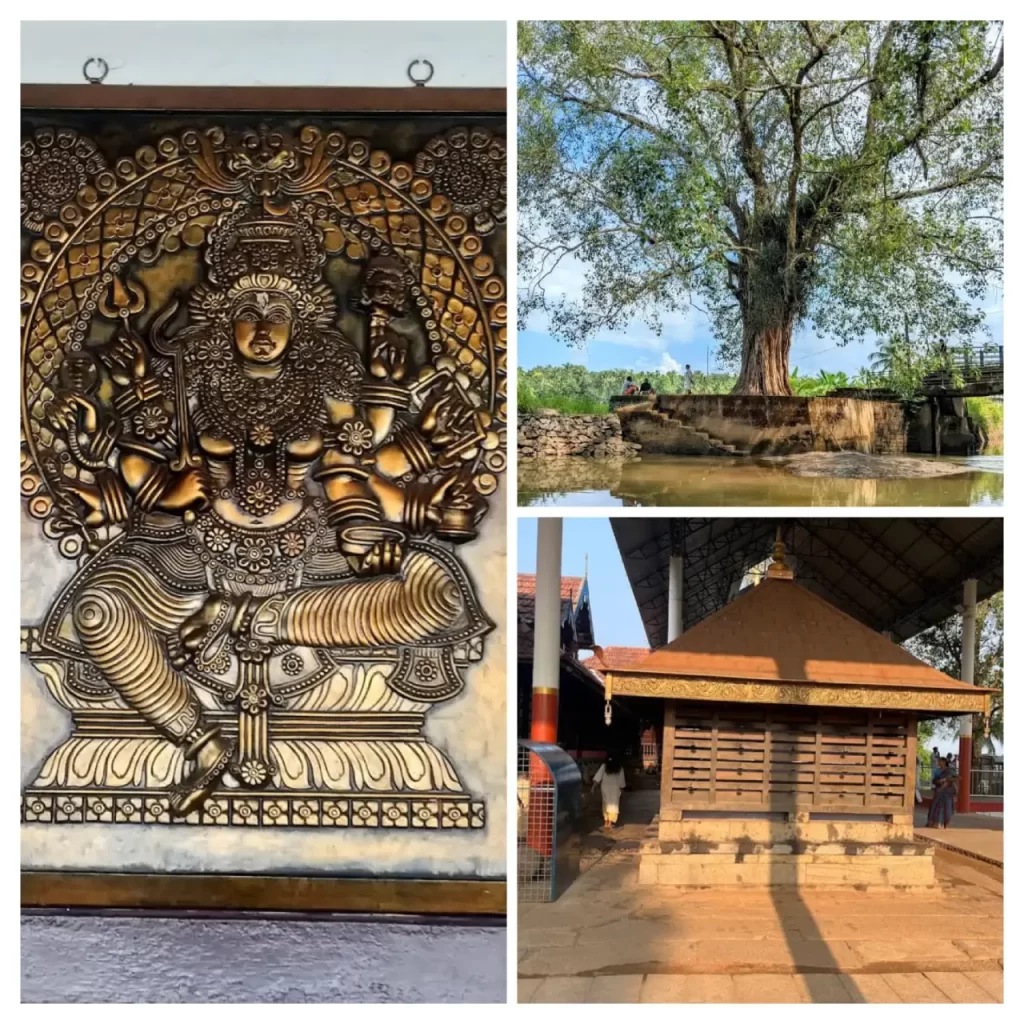
Tales from the Heavens: The Legend of Thirumandhamkunnu Temple
Each and every ancient temple has its own interesting tale, its own legend that makes it all the more interesting, and the Thirumandhamkunnu Temple is no different! This tale is so incredible, it goes back to the heart of Hindu mythology, from the Puranas themselves!
You want to hear how this temple was formed? Sit down! It begins with the mighty demon Darika. This Darika was troubling the world a lot, and even the gods were finding it difficult to restrain him because he possessed a special boon, which made him extremely powerful. So, all the gods approached Lord Shiva, the mighty God of creation and destruction, and requested assistance.
Lord Shiva, being all-knowing, produced a very mighty Goddess, Bhadrakali, from his third eye. She was very powerful and fierce and radiated divine light, and she was commissioned to kill Darika. Bhadrakali battled Darika gallantly and ultimately killed him, restoring peace to the world.
Now, this is where our Thirumandhamkunnu Temple tale really starts! When Goddess Bhadrakali defeated Darika, she was extremely strong and desired to rest and bless the world. It is said that this is the actual place, this very Thirumandhamkunnu, where she chose to settle down.
But wait, there’s another nice aspect of the legend, related to Lord Parashurama. Do you know Lord Parashurama? He is one of the ten avatars, or special forms, of Lord Vishnu. It is said that Lord Parashurama, who reclaimed Kerala from the sea, built many temples here. He is also said to have installed the idol of Goddess Bhadrakali in the Thirumandhamkunnu Temple. Think of it, a great sage installing this divine power right here for all of us to experience!
There’s another story that is usually told in conjunction with this, which addresses the very name of the temple itself. “Thirumandhamkunnu” is “the holy hill of the soft smile” or “the hill where godly joy resides.” This is a reference to the soft and kind form of the Goddess, even after the fierce fight. The legends inform us that Lord Shiva also visited this location, and it was a time of wonderful divine joy when the Goddess established here.
Therefore, when you see the idols within the Thirumandhamkunnu Temple, keep all these amazing tales in mind. They are not tales; they are the heart and soul of how this location is so unique.
Read More>> Divine Mata Vaishno Devi Temple | Shaktipeeth Complete Guide

Why This Place is Special: The Significance of Thirumandhamkunnu Temple
Aside from the intriguing history and mythology, the Thirumandhamkunnu Temple is also very meaningful for a lot of people. It’s not somewhere to pass by; it’s somewhere that many people go to feel part of something greater than themselves.
To begin with, it’s one of Kerala’s most significant Shakti Peethas. A Shakti Peetha is an extremely powerful spot where the divine feminine power, or Shakti, is particularly prevalent. Individuals are of the view that if you pray here with a clean heart, Goddess Bhadrakali will fulfill your desire, safeguard you, and bless you with happiness and success. For kids, it’s like a superhero who hears your wish and supports you when you really need it! Many visit here just for health, wealth, and well-being related blessings.
Secondly, the Thirumandhamkunnu Temple is extremely popular for a special puja called the Mangalya Puja. This puja is for those who want to marry or for those who wish to have a happy married life. It’s believed that if you do this puja sincerely, the Goddess will grant you a good spouse and a joyful marriage. Thus, numerous youths and girls and boys, and their families, come from far and wide in pursuit of the blessings of the Goddess for the future. It’s a location where dreams for love and companionship are fostered.
Also, for the community residing nearby, the Thirumandhamkunnu Temple is the central place of their culture and tradition. Various festivals and celebrations throughout the year take place just here, uniting everybody. It’s a site where generations have gathered, from small children like you to wise elders, all basking in the joy and fervor. This temple is a shining star of hope, a center for peace, and a reminder of Kerala’s powerful spiritual heritage. It is indeed a geographical landmark, but more importantly, a landmark in the hearts of millions.
Read More>> 8 AD Lalmati Duramari Ganesh Temple
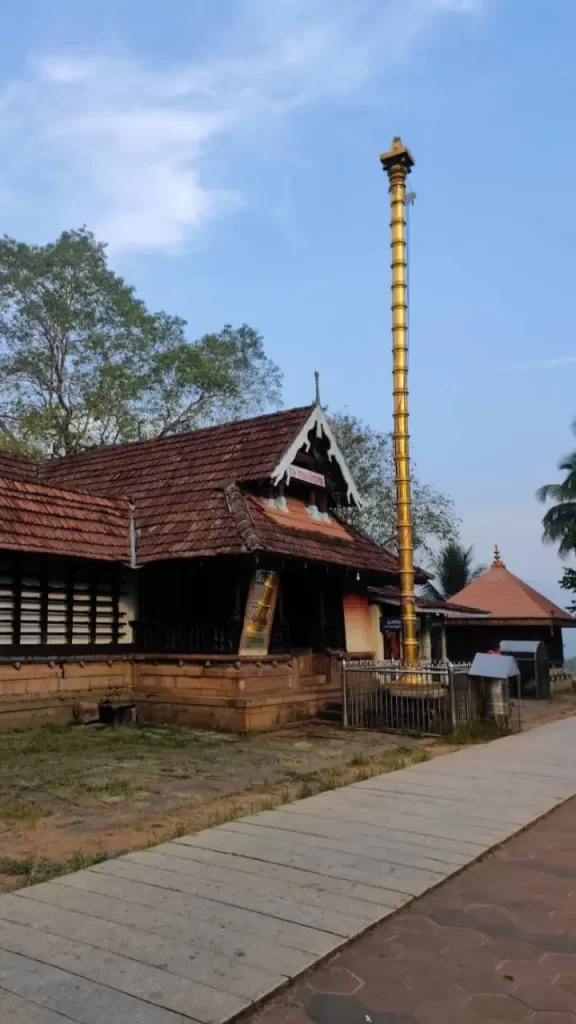
Astonished by the Art: The Architecture of Thirumandhamkunnu Temple
Now, let’s stop for a second and observe the temple itself. How the Thirumandhamkunnu Temple has been constructed is quite gorgeous and a reflection of the incredible builders of yesteryears. Kerala temples are distinctly styled, and this one is no exception.
As you go around, you’ll see that most of the temple is constructed of wood and laterite stone. Laterite is a reddish-colored stone in Kerala, and it makes the temple look warm and welcoming. The roofs are usually sloping and tiled with terracotta tiles, which are ideal for the rainy climate here. It’s like an exceedingly large, comfortable house, but for the Gods!
The central shrine, or sreekovil, housing the idol of Goddess Bhadrakali is typically circular or square. The wooden panels and stone walls have intricate carvings depicting tales from the Puranas or other deities. Picture artists from centuries ago, painstakingly carving these lovely patterns with their own hands! Each detail is a work of art.
One of the most distinctive aspects of Kerala temples such as Thirumandhamkunnu Temple is the Koothambalam. This is a dedicated theatre-like building in the temple compound, where ancient art forms like Koothu and Koodiyattam (ancient drama and dance) are performed. It’s having your own personal stage in the temple, where stories of the gods are acted out through music and dance.
You’ll also see a tall flagstaff, known as a dhwajastambham, typically brass or gold-covered, pointing straight up towards the sky. And surrounding the main temple, you’ll see smaller temples for other gods and goddesses, such as Lord Shiva (who is also very significant here!), Lord Ganesha, and so on. It’s a large family of gods, all together in one lovely house. The elegance and simplicity of the architecture of the Thirumandhamkunnu Temple really make it a peaceful and sacred haven.
Whispers of the Divine: Myths and Beliefs at Thirumandhamkunnu Temple
Each ancient site, particularly a temple such as the Thirumandhamkunnu Temple, attracts many fascinating myths and beliefs over the centuries. These are the tales that people share among themselves, from grandparents to their grandchildren, making the temple even more vibrant and enchanting.
One of the general beliefs associated with the Thirumandhamkunnu Temple is related to the efficacy of genuine prayer. The people firmly believe that if you genuinely pray to Goddess Bhadrakali from a really pure heart, she will always hear and assist you in getting out of any trouble. It is as if you have a very caring and powerful mother who is always with you. Many devotees recount personal experiences of desires being fulfilled or issues resolved after visiting and praying here.
There’s also very strong faith in the prosperity of some offerings. For example, giving nalikeram (coconut) or pattu (silk cloth) to the Goddess is very powerful. People believe that these offerings, given with devotion, appease the Goddess and bring prosperity. Think of giving a nice gift to someone you respect and love, and that’s how people feel when they give these offerings.
Another interesting thing is the special emphasis on Pooram festival. This is the biggest festival of Thirumandhamkunnu Temple, generally held in March or April. During Pooram, it is believed that all the divine forces converge at the temple. The atmosphere reverberates with enthusiasm, and people feel that attending the festival bestows huge good fortune and spiritual value. It is not merely a celebration; it is a deep spiritual experience for thousands.
You may also come to know about the kalamezhuthu paattu, a ritual art in which the Goddess’s image is painted on the floor with colored powders, and specific songs are rendered to seek her blessings. This is a highly complex and elegant form of art, said to be very powerful in appeasing the deity and repelling evil forces. These are not mere age-old customs; they are living acts of religious faith and worship that still prosper in the Thirumandhamkunnu Temple.
Read More>> Karpaga Vinayagar Temple Pillayarpatti – 5th century Temple
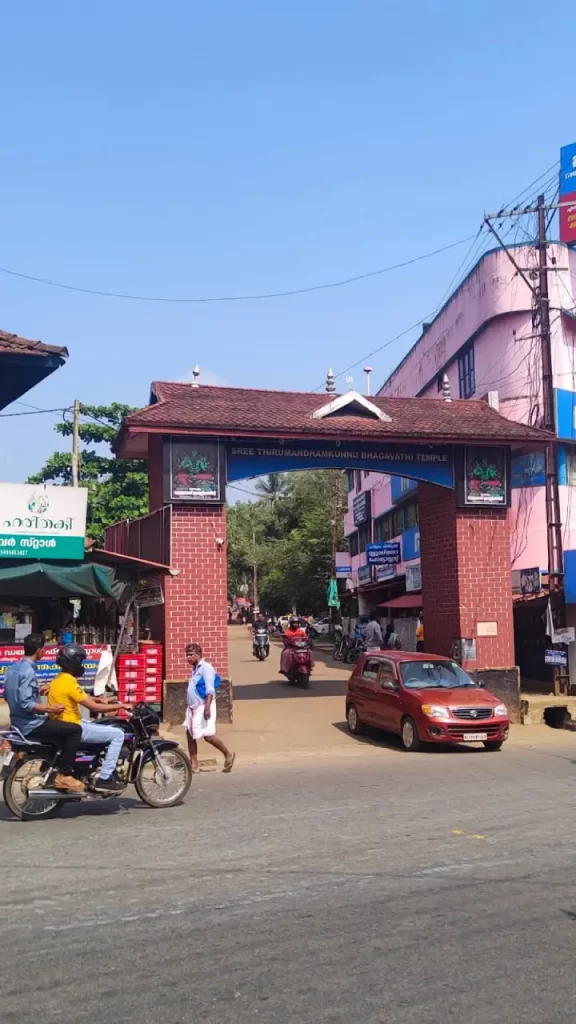
When to Visit: Thirumandhamkunnu Temple Timings
It’s always nice to know when the temple is open, isn’t it? Just as your school has timings, temples also have certain timings during which you can visit and pay your respects and enjoy the serene environment. The Thirumandhamkunnu Temple usually follows a schedule that has been in practice for ages.
The temple normally opens early in the morning, near 5:00 AM, and closes briefly in the afternoon, typically between 12:00 PM to 4:00 PM. It then opens again in the evening, from approximately 4:00 PM to 8:00 PM. These hours provide time for multiple pujas (worship rituals) and abhishekam (ritual bathing of the idol) to be conducted by the priests.
Just remember that these timings may change a little bit, mainly during festivals or festivals’ times. For example, during major festivals such as Pooram, the temple may remain open for extended hours, and there will be lots of special ceremonies all day and night. It’s always better to see the official website of the temple or call them quickly if you are planning your visit on a particular date, particularly during the time of a festival. But ideally, the morning and late afternoon times are the most suitable times to witness the peaceful charm and religious vibration of the Thirumandhamkunnu Temple.
Beyond the Temple Walls: Hindu Places to Visit Near Thirumandhamkunnu Temple
Our adventure doesn’t have to stop at the Thirumandhamkunnu Temple! Kerala is a state full of temples and holy places, and if you have extra time, there are some beautiful places close by that you may also like to visit. It’s a treasure hunt for more great stories and stunning views!
Pattambi Perumudiyoor Temple: Just a short distance from Angadipuram, where our temple is situated, is the Pattambi Perumudiyoor Temple, a temple of Lord Shiva. It’s a calm, ancient temple too and another one of tranquil spiritual experience in a different kind. It’s a lovely place for contemplative quietude.
Sree Kadampuzha Bhagavathy Temple: It’s another extremely popular temple of Goddess Bhagavathy, believed to grant desires and resolve issues. It’s not far from here and is a highly powerful temple, particularly for prosperity and protection blessings. A lot of people go to both Thirumandhamkunnu Temple and Kadampuzha in the same visit.
Vettakkorumakan Temple, Thrissur: Little farther, but if you are venturing out in the area, Thrissur has numerous grand temples, one of which is the popular Vadakkunnathan Temple. Vettakkorumakan Temple is another.
Navamukunda Temple, Tirunavaya: An extremely old and holy temple of Lord Vishnu on the banks of River Nila (Bharathapuzha). It is one of the 108 Divya Desams (sacred homes of Vishnu). It is a bit of a drive, but if you are temple-goer who appreciates serious historical significance, it’s a must-see.
Bharatannoor Sree Dharmasastha Temple: It’s a stunning temple in honor of Lord Ayyappan, a favorite god of Kerala. It’s famous for its serene environment and lovely natural landscape.
Visiting these nearby temples following a visit to the Thirumandhamkunnu Temple provides you with a richer understanding of Kerala’s rich spiritual heritage and the strong devotion of its people. Every temple is unique in its charm and history, just waiting to be explored!
Your Journey to the Divine: How to Get to Thirumandhamkunnu Temple
Okay, my curious explorers, now that you’ve learned all about the wonderful Thirumandhamkunnu Temple, it’s time to discuss how you can actually get here! It’s simpler than you might think, and Kerala has excellent connections to guide you to this divine site.
Thirumandhamkunnu Temple is in Angadipuram, a quaint town in the Malappuram district of Kerala.
By Air (Flying like a bird!):
The closest airport is Calicut International Airport (CCJ) or Karipur Airport. It’s roughly 40-50 kilometers from Angadipuram. As soon as you arrive, you can find cabs or taxis right outside the airport to drive you straight to the temple. The ride is very scenic, with palm trees and green fields all over! The second choice, a little farther but also within reach, is the Cochin International Airport (COK), some 120-130 kilometers away. You can also take a taxi or train there.
By Train (Riding the iron horse!):
The good news is that Angadipuram does have its own railway station, and it’s called Angadipuram Railway Station (AUP). How convenient! There are several trains that link Angadipuram with big cities of Kerala and other states in India. Thus, you could easily catch a train, and it will deliver you nearly to the temple entrance. It’s a wonderful way of viewing the lovely Kerala landscape while en route. The closest major railway station is Shoranur Junction (SRR), which is highly connected to the main cities of India. From Shoranur, you can get a local train or taxi to Angadipuram.
By Road (Driving through green landscapes!):
If you are crazy about road trips, this is an ideal choice! Angadipuram is well connected by road. National Highway 966 (NH 966) runs very close to this place, and hence it is quite easy to get there from various cities in Kerala as well as nearby states. You can go by bus – government-owned (KSRTC) as well as private buses have regular services to Angadipuram from all major cities and towns in Kerala. Or, if you like, you can take a private taxi or drive your vehicle. The roads are quite good, and the ride is full of picturesque visions of the lush greenery of Kerala.
Whichever way you travel, arriving at the Thirumandhamkunnu Temple is also part of the experience. You will be immersed in the one-of-a-kind beauty of Kerala, which will enhance your pilgrimage even more.









